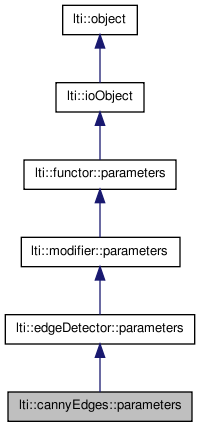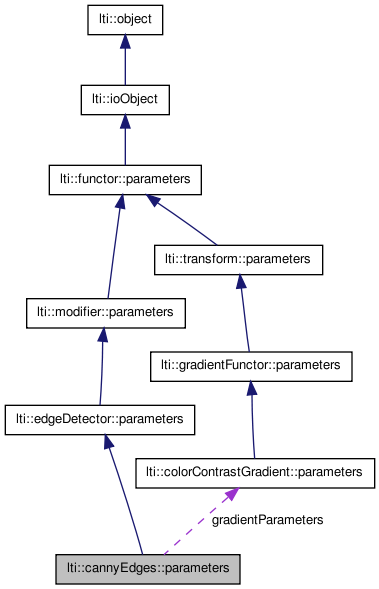

|
latest version v1.9 - last update 10 Apr 2010 |
|
the parameters for the class cannyEdges More...
#include <ltiCannyEdges.h>


Public Member Functions | |
| parameters () | |
| parameters (const parameters &other) | |
| ~parameters () | |
| const char * | getTypeName () const |
| parameters & | copy (const parameters &other) |
| parameters & | operator= (const parameters &other) |
| virtual functor::parameters * | clone () const |
| virtual bool | write (ioHandler &handler, const bool complete=true) const |
| virtual bool | read (ioHandler &handler, const bool complete=true) |
Public Attributes | |
| float | variance |
| int | kernelSize |
| float | thresholdMin |
| float | thresholdMax |
| colorContrastGradient::parameters | gradientParameters |
the parameters for the class cannyEdges
| lti::cannyEdges::parameters::parameters | ( | ) |
default constructor
Reimplemented from lti::edgeDetector::parameters.
| lti::cannyEdges::parameters::parameters | ( | const parameters & | other | ) |
copy constructor
| other | the parameters object to be copied |
Reimplemented from lti::edgeDetector::parameters.
| lti::cannyEdges::parameters::~parameters | ( | ) | [virtual] |
destructor
Reimplemented from lti::edgeDetector::parameters.
| virtual functor::parameters* lti::cannyEdges::parameters::clone | ( | ) | const [virtual] |
returns a pointer to a clone of the parameters
Reimplemented from lti::edgeDetector::parameters.
| parameters& lti::cannyEdges::parameters::copy | ( | const parameters & | other | ) |
copy the contents of a parameters object
| other | the parameters object to be copied |
Reimplemented from lti::edgeDetector::parameters.
| const char* lti::cannyEdges::parameters::getTypeName | ( | ) | const [virtual] |
returns name of this type
Reimplemented from lti::edgeDetector::parameters.
| parameters& lti::cannyEdges::parameters::operator= | ( | const parameters & | other | ) |
copy the contents of a parameters object
| other | the parameters object to be copied |
Reimplemented from lti::edgeDetector::parameters.
| virtual bool lti::cannyEdges::parameters::read | ( | ioHandler & | handler, | |
| const bool | complete = true | |||
| ) | [virtual] |
read the parameters from the given ioHandler
| handler | the ioHandler to be used | |
| complete | if true (the default) the enclosing begin/end will be also written, otherwise only the data block will be written. |
Reimplemented from lti::edgeDetector::parameters.
| virtual bool lti::cannyEdges::parameters::write | ( | ioHandler & | handler, | |
| const bool | complete = true | |||
| ) | const [virtual] |
write the parameters in the given ioHandler
| handler | the ioHandler to be used | |
| complete | if true (the default) the enclosing begin/end will be also written, otherwise only the data block will be written. |
Reimplemented from lti::edgeDetector::parameters.
Parameters for gradient computation.
To provide more alternatives to the gradient computation, the lti::gradientFunctor is used. Here you can select all options available for that functor.
The default behaviour is to use the lti::gradientFunctor::parameters::Difference kernel, which is the fastest but also the less precise. You can use the optimal kernels if you require a more stable orientation detection.
Default value: Difference mode (fast gradient computation)
Size of the Gaussian kernel used to smooth the image (see also variance).
Set to zero if you don't want any smoothing.
Default value: 7
If an edge response is higher than this value, those pixels will be definite an edge.
This value MUST be between 0 and 1.0.
Please note that the older value range between 0 and 255 is deprecated.
Default Value: 0.04f;
If a pixel is detected as part of an edge (a response higher than thresholdMax), its neighbors are consider also edges if their values are higher than the given percentage of thresholdMax (i.e.
higher than thresholdMax*thresholdMin)
This value must be between 0.0 and 1.0
Default Value: 0.5
Variance for the Gaussian to smooth the image.
(see also gaussKernel1D<ubyte>::gaussKernel1D())
Default value: 1.0